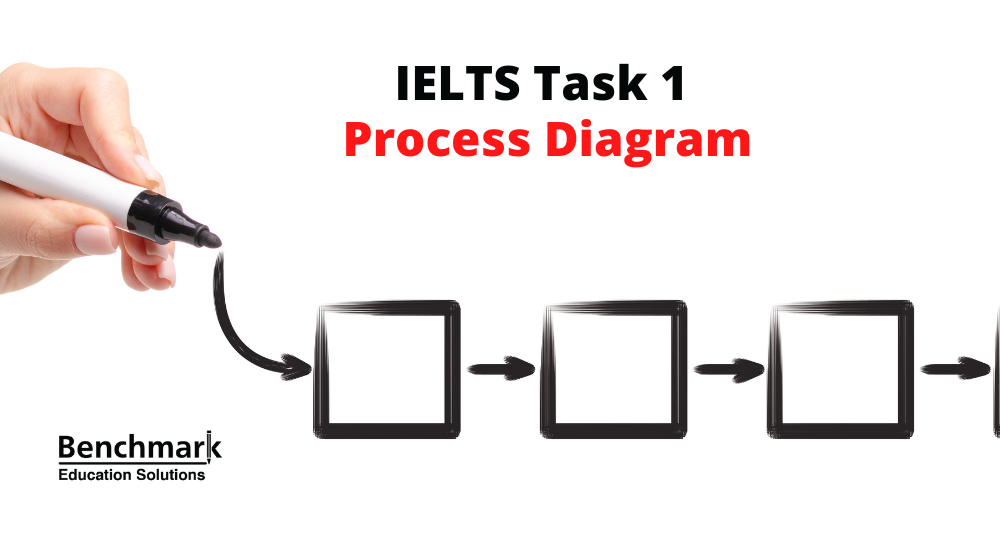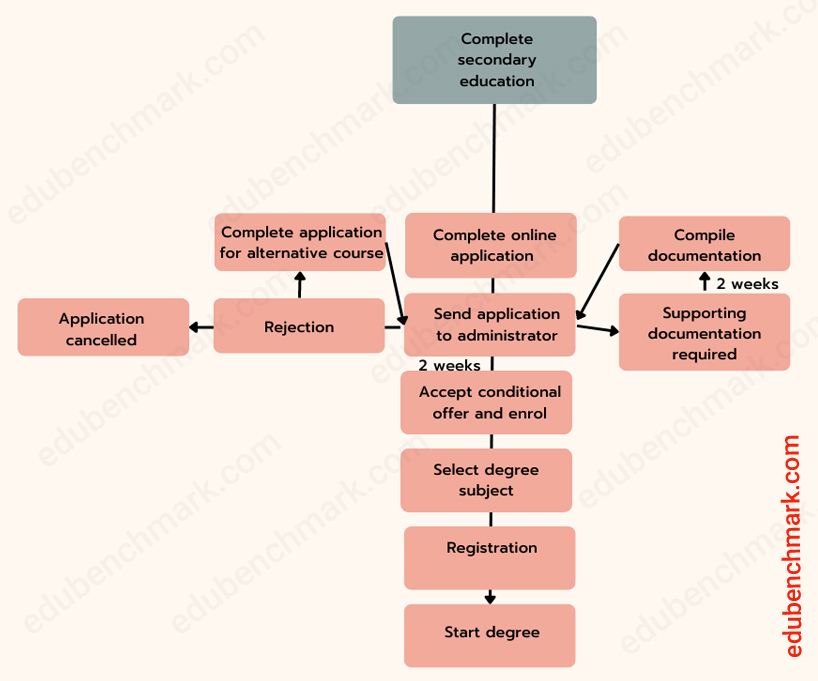

This guide will help you to understand process diagrams and flow charts for IELTS Academic Writing Task 1.
Table of Contents
- IELTS Process Diagram/Flow Chart Overview
- IELTS Task 1 Process Diagram and Flow Chart Questions
- Structure for IELTS Process Diagram/Flow Chart Questions
- IELTS Writing Task 1 Band Descriptors Explained
- Vocabulary for IELTS Process Diagrams/Flow Charts
- Grammar for IELTS Writing Task 1 Process Diagrams/Flow Charts
- IELTS Writing Task 1 Process Diagram Sample Answer
- Common Mistakes in IELTS Report Writing and How to Avoid Them
- Quiz- Check Your Understanding
1. IELTS Process Diagram/ Flow Chart Overview
Process diagrams and flow charts fall under the same category as they require the same type of response and approach. They are not a very common IELTS writing task 1 question in the exam.
An IELTS process diagram will illustrate several stages of a process using pictures. A flow chart is visually more simple and will illustrate a process using a series of boxes and directional arrows.
Although a process diagram/flow chart is not a very common IELTS writing task 1 question type, it is important to be prepared in case it comes up in your IELTS exam.
1.1 Objective
The main aim of this task is to produce a minimum of 150-word report that summarises, reports and compares the main features of the process diagram or flow chart.
1.2 Skills Used
Even though the information in a process diagram/flow chart is being presented using pictures or boxes, you are still being tested on the same skills as you need for graphs and charts in IELTS writing task 1.
You need to select the key features of the diagram or chart, summarise the important information and make comparisons when it is appropriate.
The tone of your report should be formal and you must write at least 150 words.
2. IELTS Task 1 Process Diagram and Flow Chart Questions
The process diagram/ flow chart will either describe a natural process or a production process. Sometimes a decision making process can be there – for instance, steps to buying a house. Here is an example of the process of producing and making a cup of tea:
2.1 Process Diagram
The picture below show how tea is produced and then illustrate the process of making a cup of tea.
Summarise the information by selecting and reporting the main features making comparisons wher relavant.



2.3 Flow Chart
Below is an example of a flow chart that illustrates a the process of enrolling at a university:
The diagram shows the procedure for successful high school graduates to enrol at university.
Summarise the information by reporting and selecting the main features making comparisons where relevant.


3. Structure for IELTS Process Diagram/ Flow Chart Questions
You should write your report for these question types using a clear structure and logical paragraphing. Read on for more information about what to include in each paragraph.
3.1 Introduction and Overview
Unlike your response to an IELTS graph, chart, map or table, you do not need to separate your introduction and overview paragraph for a process diagram/ flow chart.
In this paragraph, you need to summarise the diagram or chart in one statement. You must include all the key features. This is the most important paragraph in IELTS writing task 1.
Here are some useful phrases to introduce your first paragraph:
- The flow chart show information about…
- The pictures in the process diagram illustrate information about…
- The diagram illustrates information about…
- The diagram shows information about…
Here are some sentence endings for the process of tea (tea could be replaced with the relevant process for your question):
The diagram shows information about…
- …how to grow tea
- …how a cup of tea is made
- …the process of growing tea
- …the process by which tea is grown
- …the steps involved in growing tea
- …the stages of making a cup of tea
3.2 Main Body Paragraphs
Your main body paragraphs should go into more detail than your overview. Note that you do not have to separate your body paragraphs according to the number of diagrams. For example, there are four diagrams, you do not need to write four paragraphs: we recommend you write one or two paragraphs.
Here are some more helpful hints for your main body paragraphs:
- You should write about each stage of the process, but you will be able to write about some in more detail than others
- Use the vocabulary that is given to you in the diagrams
- You will need to change the tense of any sentences you are given (e.g. the imperative ‘dry the leaves’ would need to be changed to the passive ‘the beans are dried’)
- Use a mix of the passive and active voice. Keep in mind that passive voice helps to explain a process better.
- When using the passive voice and, if you think it is necessary, you can add the agent to the end of the sentence e.g., ‘after the tea is picked by the workers’
- Use linking phrases to describe the start, next stages or end of a process (see Vocabulary for IELTS Process Diagrams/Flow Charts)
4. IELTS Writing Task 1 Band Descriptors Explained
Our section on IELTS Writing Band descriptors in our IELTS writing Task 1 Masterclass is full of helpful hints for each marking criterion.
5. Vocabulary for IELTS Process Diagrams/Flow Charts
5.1 Linking Phrases for Process Diagrams/Flow Chart
You should use a range of linking phrases throughout your report.
You can use the following linking words and phrases to describe the start, next stages and end of a process:
| Start | Next stage | End |
|---|---|---|
| In the first stage,… | After that,… | Finally,… |
| The first stage is that,… | …, after which… | In the final stage,… |
| Initially,… | …and then… | The final stage is that,… |
| To begin with,… | At this point,… | |
| Next,… | ||
| Following this,… | ||
| In the next stage,… | ||
| Subsequently,… | ||
| The following step is that,… | ||
| The next step is that,… | ||
| Then,… |
6. Grammar for IELTS Process Diagram/Flow Charts
6.1 Present Simple Passive
The present simple passive is useful for describing a process because you can put focus on the object involved in the process.
Present Simple Passive Form:
Object + is/are + past participle
Examples:
The tea is picked and put into baskets.
The tea is boxed and delivered to supermarkets.
The water is boiled and then poured into the cup.
6.2 Present Perfect Passive
The present perfect passive is useful when you want to write about two stages of the process in one sentence.
Present perfect passive form:
Object + have/has + been + past participle
In the first part of the sentence, use the words:
- Once
- When
- After
Examples:
Once the tea leaves have been picked, they are placed into a basket.
When the tea has been picked, it is packed into boxes.
After the tea has been put into boxes, it is driven to supermarkets.
6.3 Participle Structures
The present simple passive can be replaced by a participle structure. This will help to increase your grammatical range.
Participle forms:
After being + past participle + subject + second half of sentence
Having been + past participle + subject + second half of sentence
Examples:
Having been picked from the field, the tea leaves are placed into a basket.
After being packed into boxes, it is driven to supermarkets.
7. IELTS Writing Task 1 Process Diagram Sample Answer
The pictures below show how tea is produced and then illustrate the process of making a cup of tea.
Summarise the information by selecting and reporting the main features making comparisons where relevant.



Sample
The diagram shows information about the process of growing tea and the steps involved in making a cup of tea. There are thirteen stages in the process, beginning with the growing and sowing of the tea seeds in India and China and finishing with drinking a cup of tea.
In the first and second stage, tea leaves are sown and grown in India and China, left to grow in the sun and then the leaves are picked and put into baskets. Once the leaves have been picked, they are packed and put into boxes before being loaded onto lorries and delivered to supermarkets. Having been delivered, the tea is then purchased and taken home by customers.
If we look at the process of making a cup of tea, to begin with the customer first boils a kettle of water. After the water has boiled, they then add the tea bag to the cup before adding the desired amount of milk and sugar. The final stage is that the tea can be drunk and enjoyed. This completes the process of making a cup of tea from beginning to end.
7.1 Sample Answer Commentary
The report above would receive an estimated 9.0 overall in the IELTS writing task 1 Academic paper.
It has been organised into logical paragraphs that are clearly divided into an introduction/overview and then two main body paragraphs separated into the first and last stages of the process. All stages of the process have been mentioned.
The minimum 150 words has been exceeded. The report is written in a formal style (the write has not included their opinion and has not used informal language)
The passive voice has been accurately used throughout the report, for example ‘Once the leaves have been picked’. Lexical items such as ‘once’ and ‘after’ have been used to create order and cohesion. The present perfect passive has been used to introduce more than one process in a sentence, e.g. ‘After the water has boiled, they then add the tea bag to the cup’.
Linking phrases such as ‘In the first and second stage…’ and ‘The final stage’ have also been used to order the process. The participle sentence ‘Having been delivered, the tea is then purchased and taken home by customers’ also adds to the grammatical range.
8. Common Errors and How to Avoid Them
8.1 Problem 1
Problem 1
Not using the passive voice effectively.
Solution 1
You need to use the passive voice when describing an IELTS process diagram or flow chart because it is often not clear who is doing the action and you want to put focus on the object of the sentence. Make sure you practise forming the present simple passive and present perfect passive as these will be very useful when writing this type of report.
8.2 Problem 2
Problem 2
Missing some of the stages in the diagram.
Solution 2
You should aim to write about each stage of the process. However, this does not mean you need to go into detail for each stage and you will have more to write about some stages than others.
9. Quiz- Check Your Understanding
Take this short quiz to test your understanding of writing task 1 and process diagrams/ flow charts:








